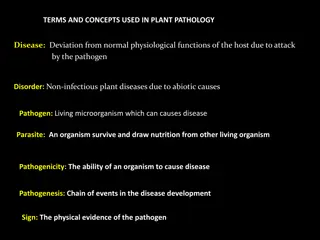Understanding Plant Pathology: Importance, Scope, and Objectives
Plant pathology, also known as phytopathology, is the study of plant diseases and their management. It covers the causes, symptoms, and impact of pathogenic organisms on plants. The field aims to understand the interactions between plants and pathogens, develop control methods, and reduce losses in plant production. Plant diseases have significant economic, environmental, and health consequences, making the study of plant pathology crucial for agricultural sustainability and food security.
Download Presentation

Please find below an Image/Link to download the presentation.
The content on the website is provided AS IS for your information and personal use only. It may not be sold, licensed, or shared on other websites without obtaining consent from the author. Download presentation by click this link. If you encounter any issues during the download, it is possible that the publisher has removed the file from their server.
E N D
Presentation Transcript
Lecture 1 Introduction: Importance, scope and objectives of Plant Pathology INTRODUCTION Plant Pathology/ Phytopathology (Phyton=plant, Pathos=suffering, ailment, Logos=study) ie., the study of nature, developmentand managementof plantdiseases. Definition: A branch of Agricultural science which deals with cause,etiology,resulting losses and managementof plantdiseases. Pathogen: A micro organism thatcan incitedisease in susceptible plants. Plant Disease: (dis-un, ease-comfort):It is the malfunctioning of host cells and tissue that results from continuous irritation by a pathogenic agent and leads to development of symptoms.
Symptoms: External or internal reactions or alterations of a plant as a result of disease Important Phytopathogenic organisms : 1.Fungi 2.Bacteria 3.Fastidious vascular bacteria (RLO s) 4.phytoplasma 5.viruses 6.viroids 7.Algae 8.Flagellated protozoans . Plant Pathology relation with other sciences Virology Soil Science Mycology Physiology Biochemistry Plant Pathology Bacteriology Genetics Biotechnology
Importance of Plant Pathology 1. Plant diseases are of paramount importance to humans because they damage plants and plant products 2. Millions of people all over the world still depend on their own plant produce for their survival 3. Plant diseases reduce the quality and quantity of plant produce 4. Severe pathological effects on humans and animals that eat plant products 5. Destroy beauty of environment by damaging plants around home, park and forests 6. The pesticides used to control disease, pollute the water and environment
7. Cause financial loss ie., the money spent for plant protection chemicals 8. Changes agricultural pattern 9. Influences the industries ie., lack of raw material 10. Some plant diseases even change food and drinking habits of people Few examples of serious plant diseases 1. Lateblight of potato- Phytophthora infestans- Irish famine (1845) 2. Brown spot of rice- Bipolaris oryzae- Bengal famine (1942-43) 3. Coffee rust- Hemileia vastatrix (1868), SriLanka 4. Wheat rust- Puccinia graminis f.sp.tritici (1940), USA 5. Southern corn leaf blight- Bipolaris maydis (1970), USA
1. Lateblight of potato 2. Brown spot of rice 3. Coffee rust 4. Wheat rust 5. Southern corn leaf blight
Objectives of Plant Pathology 1. To study the living, non-living and environmental causes of plant diseases 2. To study the mechanisms of disease development by pathogens 3. To study the interactions between the plants and the pathogen 4. To develop the Control method thereby reducing the losses caused by them.























